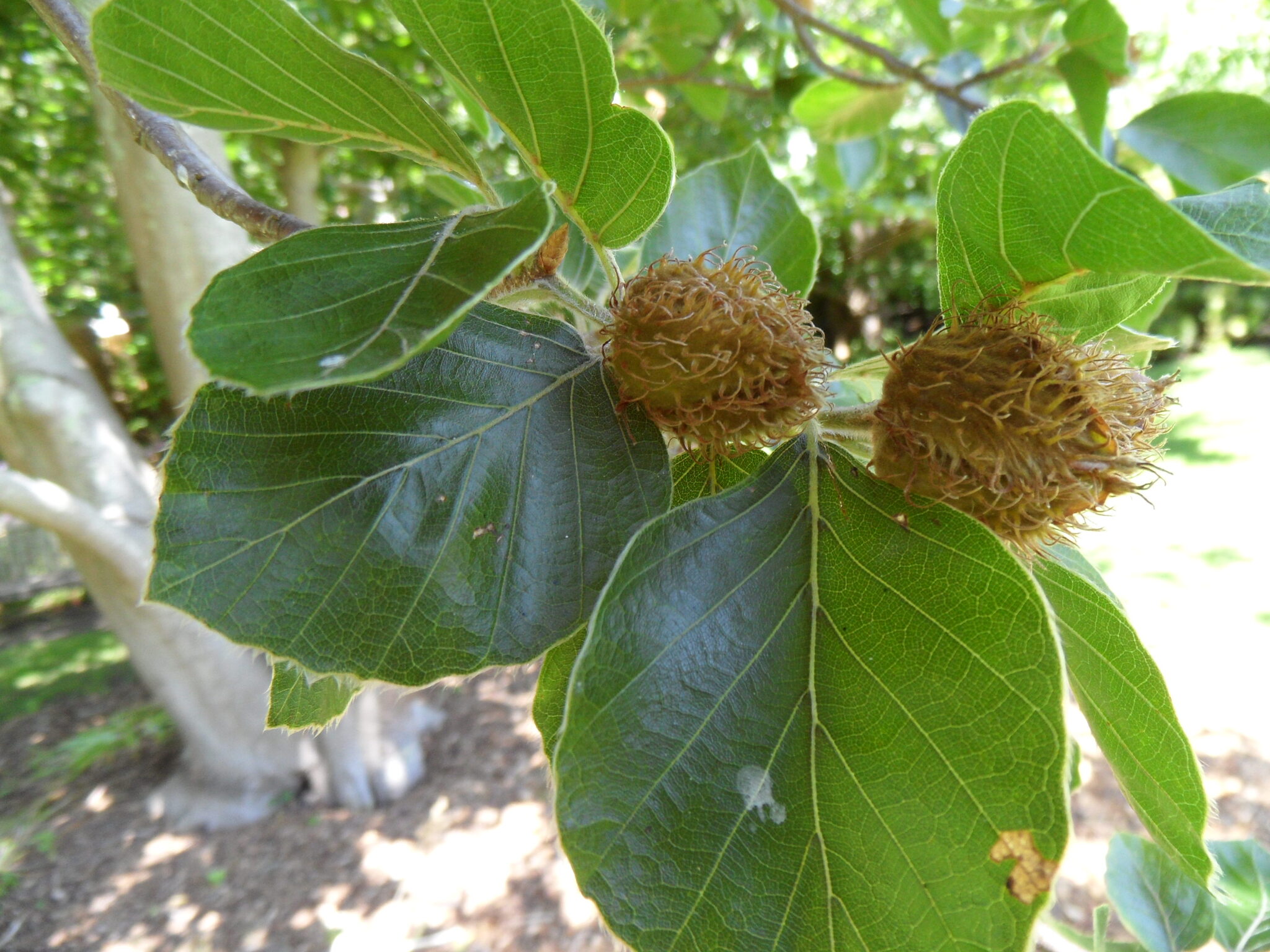
Tree 15-30 m or so tall. Bark smooth, grey. Winter buds dull, about 3 cm long. Leaves ovate to elliptic, 4-10 cm long, 5-7 cm wide, pointed and with small, well spaced teeth, generally wavy, silky at first, later without hair, dark green colouring reddish in autumn. Leaf stalk mostly 0.5-1.5 cm long. Flowers unisexual with male flowers in small clusters before the leaves and female flowers 2, surrounded by bracts; early spring. Fruit prickly, about 2.5 cm wide, the stalks 2-3 cm long; around Sept.
C Europe to Caucasus Mts
Narrow, pointed buds; characteristic wavy-edged leaves.
NSW: Mt Wilson ('Yengo'). VIC: Bulleen (Heide Gardens and Sculpture Park); Mt. Macedon ('Alton'); Melbourne (Royal Botanic Gardens Victoria (Melbourne Gardens)). TAS: Launceston (City Park).
Copper Group Copper Beech. Better known as 'Cuprea' which is a name of uncertain status that has been used (together with the common name) for a number of clones with leaves paler than those of the Purple Beech. As several clones are involved the preferred name is Copper Group, but the distinction between members of this group and f. purpurea or the Purple Group is not always clear. ['Cuprea']
Purple Group Purple Beech. Switzerland. A collective name generally applied to trees with deep purple foliage grown both from seed or as a dark-coloured grafted clone. Growth from seed produces trees with leaves of variable size and colour intensity. As a range of clones are available under this name they are best referred to collectively as Purple Group. [f. purpurea (Aiton) Gus. Schneid, 'Atropunicea', 'Atropurpurea', 'Purpurea'].
VIC: Dandenongs (Alfred Nicholas Memorial Garden; Burnham Beeches); Emerald (Nobelius Heritage Park by office about 20 m tall 1984, and elsewhere on the site); Geelong (Geelong Botanic Gardens, 18 m tall in 1984); Leongatha (Mossvale Park); Dandenongs (Burnham Beeches); Mt Macedon ('Greystanes' about 9 m tall in 1984). TAS: Hobart (St David's Park); Launceston (City Park).
f. laciniata (Pers.) Domin Leaf serrations deep and regular with 5-9 pairs of large teeth on each side. ['Laciniata'] Sometimes confused with and merging into 'Aspleniifolia' ['Heterophylla'] which has extremely variable, sometimes entire, almost linear leaves with irregular serrations. Trees in SE Australia appear to be f. laciniata. Known since 1795.
VIC: Dromana (Arthur's Seat, 'Seawinds' Estate c. 7 m tall in 1979); Malvern (cnr Glydebourne & Moonga Sts).
f. tortuosa (Pépin) ('Tortuosa') Low-growing, spreading.
Source: (1997). Fagaceae. In: . Horticultural Flora of South-eastern Australia. Volume 2. Flowering plants. Dicotyledons. Part 1. The identification of garden and cultivated plants. University of New South Wales Press.

A name once used to distinguish grafted (clonal) Purple Beeches (and often their seedlings), now no longer used; See Purple Group. ['Atropurpurea']
Fagus sylvatica 'Atropurpurea'
See Purple Group.
Fagus sylvatica 'Aurea Pendula'
Leaves yellow, especially early in the season. Raised by J.G. van der Bom, Oudenbosch, Netherlands pre-1900.
Cockscomb Beech. Small, open, fast growing tree with short-stalked leaves clustered together at the tips of the branchlets, the individual leaves lobed and curled. Origin unknown but available since 1836.
See Copper Group.
Habit narrowly columnar. Discovered 1864 in wild near Scottish Estate in Peebleshire; raised and released by the German firm Hesse in 1913. ['Fastigiata'] 'Dawyck Purple' is upright with bronze leaves.
Vic: Dandenongs ('Pirianda').
Weeping Beech. Main branches horizontal with long drooping branchlets. Leaves glossy green. Discovered in England in 1836. [F. pendula (Loudon) Schelle]
Vic: Mt. Macedon ('Alton' 24 m tall in 1989).
Fagus sylvatica 'Purpurea Pendula'
Grafted Purple Beech. Leaves dark purple. Branches arching down from graft. Generally a rather small grafted tree. Germany, 1865.
Fagus sylvatica 'Purpurea Tricolor'
Leaves purplish, edged and striped with rose and pinkish white.
This cultivar name is now given priority over the more widely known name 'Roseomarginata'. Originated Europe, probably France in 1880s. ['Roseomarginata']
Trees in Victoria sometimes called 'Tricolor' (which has small pink-edged leaves that burn in the sun and is rarely cultivated; raised in France by Transon's Nursery, Orleans c. 1885) are best placed here.
Vic: Dandenongs (George Tindale Memorial Garden; 'Pirianda' c. 11 m in 1984); Mt Macedon ('Forest Glades' about 19 m in 1984).
See Purple Group and f. purpurea (Aiton) Gus. Schneid. See Purple Group.
Leaves very large and deep black brown, with little additional colour in autumn.
This is considered one of the most attractive purple-leaved beeches.
In Victoria specimens known by this name have only normal sized leaves and may be better placed in Purple Group or f. purpurea.
Raised by Mr Rivers of Sawbridgeworth, England, 1870.
Leaves reddish, oak-like with rounded lobing.
Raised 1894 by Prince Camille de Rohan in Czechoslovakia and introduced in 1908.\
Vic: Dandenongs ('Pirianda'); Melbourne (Royal Botanic Gardens Victoria (Melbourne Gardens), Northern Border); Sunshine (HV McKay Memorial Gardens, about 2.5 m tall in 1993).
Fagus sylvatica 'Rotundifolia'
Leaves small, round, about 2 cm long. Intd Mr Jackman of Woking, England, 1878 and where it originated in 1872.
Vic: Dandenongs ('Pirianda' about 3 m in 1984).
See 'Purpurea Tricolor'.
Leaves yellowish when young.
Zlatia is Serbian for gold.
Introduced by the Spaeth Nursery in 1892.